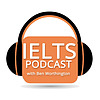
IELTS Podcast
Ben Worthington
Categories: Education
Listen to the last episode:
Describing tables in IELTS Academic Task 1 can often present unique challenges for many candidates. Unlike charts or graphs, tables may not immediately indicate trends, making it harder to identify key points at a glance. This guide will help you navigate these challenges and provide strategies for effectively describing complex tables in your IELTS exam.
Understanding the Structure and Data
When you encounter a table, the first step is to thoroughly understand the data presented. For example, a table may show the percentages of people living in poverty across different household types. It’s crucial to recognize whether the data is static or dynamic, as this will determine the type of vocabulary you use. In static tables, where there is no change over time, you should focus on comparative language rather than terms like “increase” or “decrease”.
For instance, if a table shows percentages of various household types living in poverty, you would use phrases such as “twice as high” or “half as much” to describe the data. This approach helps in clearly conveying the relationships between different data points.
Identifying Key Information
In tables, particularly those with a lot of data, it’s essential to identify the most significant figures to discuss. All categories presented in the table should be considered key information, especially when the data set is limited. This means you should mention each category at least once in your description.
For example, in a table with household types, each type—such as single parents or couples with children—should be included in your report. You might start with the category that shows the highest percentage of people living in poverty and work your way down to the lowest, providing a clear, structured overview of the data.
Crafting Your Description
Begin your report with an overview that summarises the table’s main findings. For example, “The table provides information regarding the percentages of people living in poverty across various household types. Overall, single people, both with and without children, exhibit the highest poverty rates.” This introduction sets the stage for a more detailed breakdown.
As you delve into the specifics, maintain consistency in the tense you use. If the table does not specify a time frame, you can use the present tense throughout your description. For example, “Single parents have the highest poverty rate at 21%, which is almost double the average for all households.”
It’s also helpful to use linking phrases to make comparisons or highlight noteworthy points. For example, “Interestingly, the percentage of couples with children living in poverty is close to the average for all households, at 12%.” Such comparisons not only clarify the data but also demonstrate your ability to interpret and analyse the information presented.
Additional Tips and Resources
When dealing with complex tables, practice is crucial. Regularly reviewing different types of tables and writing descriptions can help you become more comfortable with the task. Additionally, ensure that you have a strong grasp of relevant vocabulary, especially for describing static data and making comparisons.
If you’re looking to improve your overall IELTS performance, consider visiting the IELTS Online Course page, which offers comprehensive training and support.
In summary, mastering the skill of describing complex tables requires practice, an understanding of the data, and a strategic approach to reporting. By focusing on key information, using appropriate vocabulary, and maintaining a clear structure, you can effectively tackle any table description task in your IELTS exam.
Explore more tutorials and tips at
Previous episodes
-
758 - How to Describe Complex Tables (Academic Part 1)Sat, 23 Nov 2024 - 0h
-
757 - IELTS Vocabulary: Juvenile Crime in 2024Wed, 20 Nov 2024 - 0h
-
756 - General Task 1 – Your 16 Minute Crash CourseTue, 12 Nov 2024 - 0h
-
755 - Ana gets 7.5 in the Writing and Asks for a Remark in SpeakingMon, 11 Nov 2024 - 0h
-
754 - IELTS Speaking: How to Use Discourse Markers (Advanced)Mon, 11 Nov 2024 - 0h
-
753 - Speaking Confidence – Your 23 Minute Crash CourseSun, 03 Nov 2024 - 0h
-
752 - Band 9 IELTS Pronunciation: A Comprehensive GuideThu, 31 Oct 2024
-
751 - She Scored 7.5 and Goes to Taiwan for her MBA! Yay!Wed, 23 Oct 2024 - 0h
-
750 - How Does an Examiner Mark Your Speaking Test? Pronunciation ExplainedSun, 20 Oct 2024
-
749 - IELTS Vocabulary: The Influence of Social Media on Politics in 2024Thu, 17 Oct 2024 - 0h
-
748 - Overview and Tips to Improve your Performance (Speaking Part 1)Wed, 09 Oct 2024
-
747 - Most Common Grammar Mistakes in IELTS WritingMon, 07 Oct 2024 - 0h
-
746 - Why jumping from 6.5 to 7 is harder than 6 to 6.5Tue, 01 Oct 2024 - 0h
-
745 - Enhancing IELTS Speaking: Mastering Fluency and CohesionMon, 30 Sep 2024 - 0h
-
744 - Band 7 in the Writing First Time! Anna Goes to the UKSun, 22 Sep 2024 - 0h
-
743 - Part Three Tips Giving and Supporting Opinions, Talking about Advantages and DisadvantagesWed, 18 Sep 2024
-
742 - Maria Gets Band 7 and Goes to AustraliaWed, 11 Sep 2024 - 0h
-
741 - Academic Writing Task One – Marking and AssessmentSun, 08 Sep 2024
-
740 - Ola Scores 8 in the Speaking Using Online ToolsWed, 04 Sep 2024 - 0h
-
738 - IELTS Speaking: Band Descriptors ExplainedMon, 02 Sep 2024 - 0h























